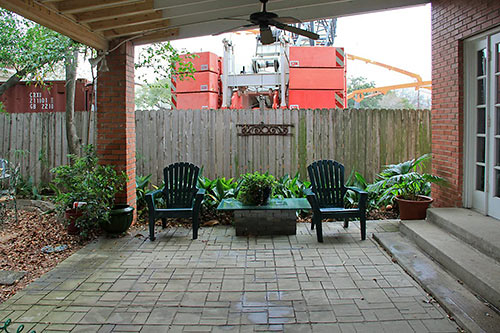COMMENT OF THE DAY: A STRUCTURAL ENGINEER EXPLAINS PARKING GARAGE COLLAPSES  “. . . Structural design is generally done by computing an anticipated load (how much will the stuff in the building weigh?), multiplying that by a safety factor, and then designing a structure with enough strength to support that “factored†load. Modern building codes also estimate the anticipated strength as less than it actually is too (for errors in materials/construction). Structures generally end up with at least 3 times as much strength as they need. That said, parking structures typically have the lowest factor of safety built into their design. They fail much more often than other building types because a) they’re so cheaply constructed, b) the loading is so much lighter than other types of structures that factoring doesn’t increase the loading by as many tons, and c) failure rarely results in loss of life.
@TL: You mentioned that there was a loud creek and then it failed? Any guess how long that creak lasted? 5 seconds, 3 minutes, an hour? I ask because concrete structures like this (ESPECIALLY pre-stressed concrete structures) are designed so that IF they fail, the rebar in them is the last thing to go, which will stretch and stretch and stretch gradually so that people have a chance to GTFO. The alternative is what’s called a brittle failure, where there’s just one loud pop and then bam; no warning at all.
. . . Engineers always talk about this stuff in terms of ‘strain’ and ‘yield.’ Strain is how much a material can deform (stretch or compress). When the strain gets too much, the structure ‘yields’ or permanently deforms. For a concrete structure, deform === collapse. The last thing to go before a concrete structure collapses is the reinforcing steel, which has a maximum strain of about 0.02 (2%) before yielding. That means if the clear span (beam-to-beam distance) is 30 feet, you can have a sag of 30 ft / 2 * 0.02 = 3.6 inches before it actually damages the structure. Parking garage widths are typically 64 feet, which can have ~7.5 inches of sag in the middle.” [Ornlu, commenting on A Top-Down View of Last Night’s Parking Garage Collapse at One Riverway] Illustration: Lulu
“. . . Structural design is generally done by computing an anticipated load (how much will the stuff in the building weigh?), multiplying that by a safety factor, and then designing a structure with enough strength to support that “factored†load. Modern building codes also estimate the anticipated strength as less than it actually is too (for errors in materials/construction). Structures generally end up with at least 3 times as much strength as they need. That said, parking structures typically have the lowest factor of safety built into their design. They fail much more often than other building types because a) they’re so cheaply constructed, b) the loading is so much lighter than other types of structures that factoring doesn’t increase the loading by as many tons, and c) failure rarely results in loss of life.
@TL: You mentioned that there was a loud creek and then it failed? Any guess how long that creak lasted? 5 seconds, 3 minutes, an hour? I ask because concrete structures like this (ESPECIALLY pre-stressed concrete structures) are designed so that IF they fail, the rebar in them is the last thing to go, which will stretch and stretch and stretch gradually so that people have a chance to GTFO. The alternative is what’s called a brittle failure, where there’s just one loud pop and then bam; no warning at all.
. . . Engineers always talk about this stuff in terms of ‘strain’ and ‘yield.’ Strain is how much a material can deform (stretch or compress). When the strain gets too much, the structure ‘yields’ or permanently deforms. For a concrete structure, deform === collapse. The last thing to go before a concrete structure collapses is the reinforcing steel, which has a maximum strain of about 0.02 (2%) before yielding. That means if the clear span (beam-to-beam distance) is 30 feet, you can have a sag of 30 ft / 2 * 0.02 = 3.6 inches before it actually damages the structure. Parking garage widths are typically 64 feet, which can have ~7.5 inches of sag in the middle.” [Ornlu, commenting on A Top-Down View of Last Night’s Parking Garage Collapse at One Riverway] Illustration: Lulu
Tag: Construction Safety

 What more quintessential closeup image of Houston is there — the kind you really aren’t likely to come across too many other places — than the one that shows a 17-story office tower under construction right next door to a single-family home? So when you hear of a Montrose resident complaining that the huge and noisy construction crane planted just a few feet beyond his fence to construct the “boutique” building at 2229 San Felipe is causing cracks in the concrete patio and the interior walls of his home, that the smell of diesel is overwhelming whether he’s in the back yard or inside on the ground floor, and that the fumes and noise from the regular Saturday concrete pours cause regular headaches for family members — well, it kinda does make you sit up and pay attention, if not simply to marvel at the unique properties of Houston development regulations and practices that allow such remarkable juxtapositions in our midst.
What more quintessential closeup image of Houston is there — the kind you really aren’t likely to come across too many other places — than the one that shows a 17-story office tower under construction right next door to a single-family home? So when you hear of a Montrose resident complaining that the huge and noisy construction crane planted just a few feet beyond his fence to construct the “boutique” building at 2229 San Felipe is causing cracks in the concrete patio and the interior walls of his home, that the smell of diesel is overwhelming whether he’s in the back yard or inside on the ground floor, and that the fumes and noise from the regular Saturday concrete pours cause regular headaches for family members — well, it kinda does make you sit up and pay attention, if not simply to marvel at the unique properties of Houston development regulations and practices that allow such remarkable juxtapositions in our midst.
Still, the owner of the home at 2244 Welch St. might be forgiven if he doesn’t get so philosophical about the wondrous scene arrayed before him. “No representative of Hines has EVER come to us to express any concern about what they are doing,” he wrote over the weekend to an online newsgroup. “Even the construction workers admit they are not comfortable with the position of this crane. So everyone else got paid off, just not us I guess.”
This past Saturday, he filed a report about the situation with the EPA. What happened next?
COMMENT OF THE DAY RUNNER-UP: WHO’S RESPONSIBLE FOR THE WORKERS “As a contractor who does both commercial and residential projects, I can tell you that the worker pay is dictated by the buyer, as is the safety, and as is everything. I can’t advertise that I pay my subs more, that I have a safer work environment, and that I’m more fair than my competitors, so YOU should pay more for my product. Especially if it is essentially the same product. I think I do pay my guys more, and I do have a safer work site, but I still cringe at some of the things that go on and I wish 5 guys didn’t have to live together to make a living. I just make less than my competitors and sleep better at night. If people were REALLY concerned about that we would have union laws like New York and California, and we would regulate the safety aspect more heavily.” [SCD, commenting on Headlines: Financing Williams Tower Purchase; Proposing a Safe-Passing Law for Houston]
COMMENT OF THE DAY: SAVES YOU MONEY!! “Harness/Lanyard runs about 400 dollars total. They must be replaced too. In addition there is significant overhead for training. Including time to train, and productivity losses. These Productivity losses amount to regulations that call for your tie off point be able to withstand a load of 5 kips (5000 lbs). So In the image where the dude is standing on a wood beam, laborers would have to construct a system for him to be tied off to. How do laborers know what can take 5000 lbs? well Scaffold builders do that a lot… how do scaffold builders do that? With an engineer who designs the scaffold? And all the time, and money trickles down to the homeowner. Finally, in the housing industry there is a large illegal immigrant workforce. They are working at lower wages [than] US citizens. If they get injured the cost vs productivity/exploitation of that illegal still falls in the companies[’] advantage.” [Enginerd, commenting on Comment of the Day: Extreme Homebuilding Makeover, Oil and Gas Edition]

